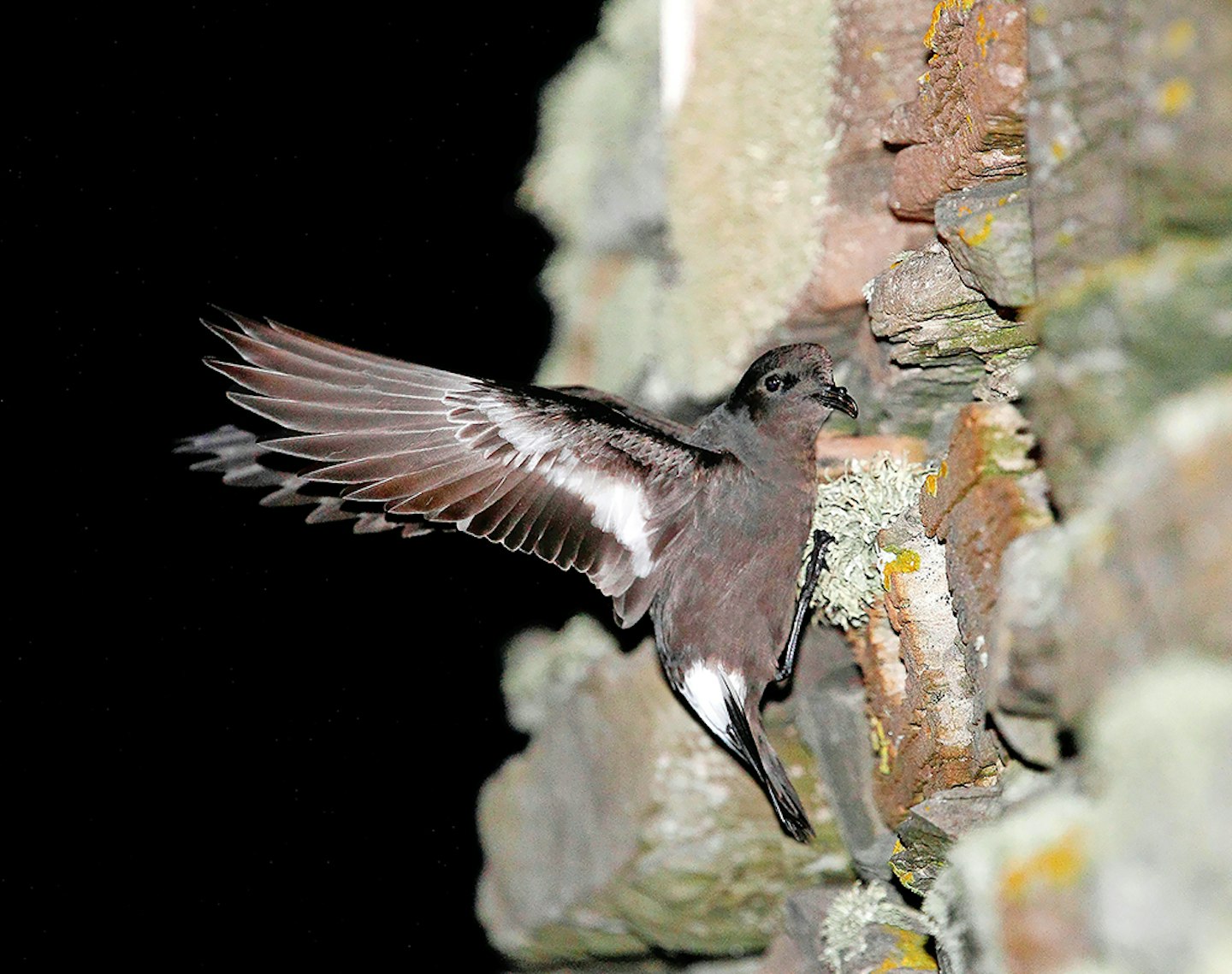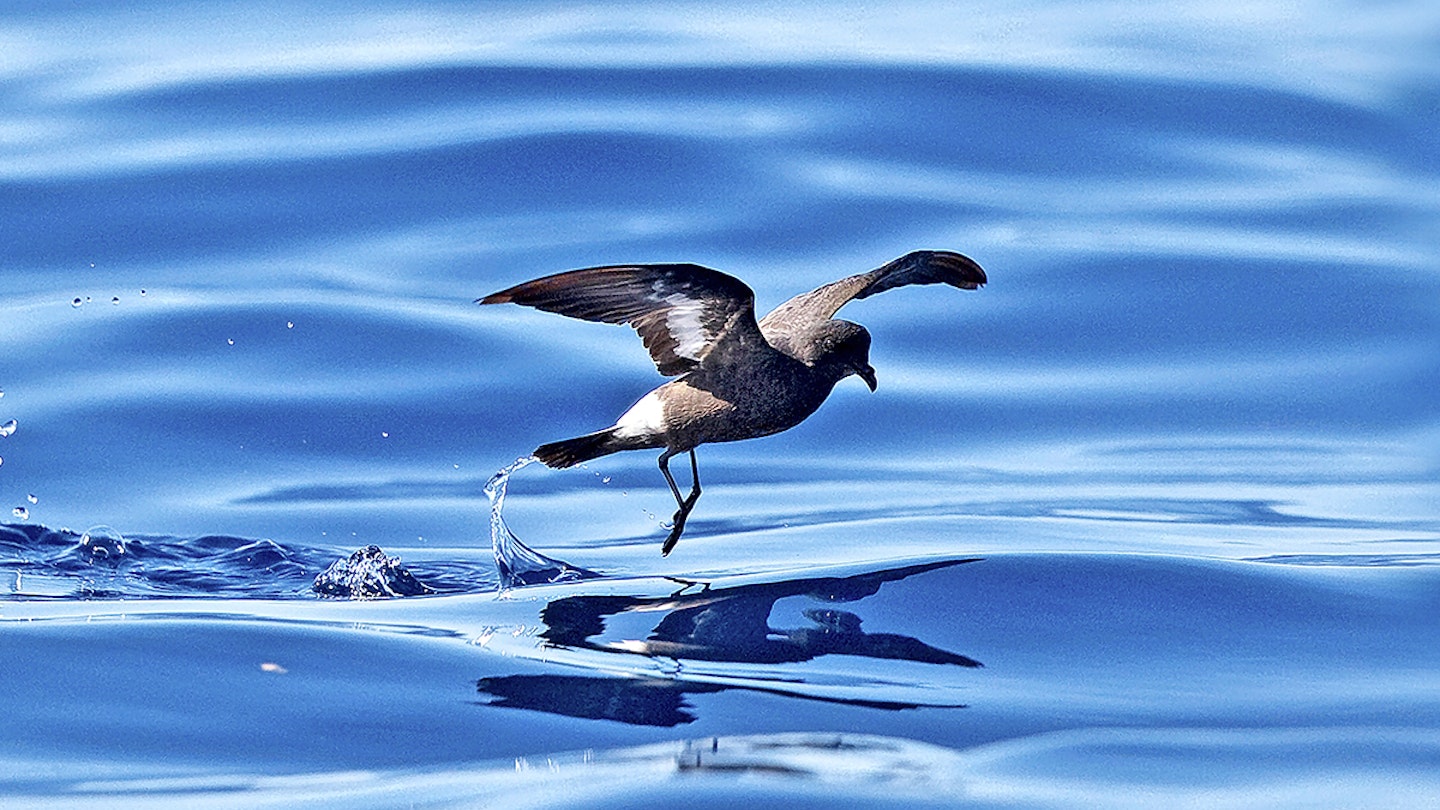Weighing the same as a sparrow, it’s amazing that these birds can cope with being battered by an angry sea – and how they feed has created intrigue, too!
Scientific name: Hydrobates pelagicus
Length: 14-18cm
Wingspan: 36-39cm
UK numbers: 25,700 breeding pairs
Habitat: Out at sea
Diet: Fish/crustaceans
Albatrosses do it and so do shearwaters. Swifts do it, quintessentially. Bitterns do it almost better than anything else. Puffins do it, but only some of the time.
But Storm Petrels don’t. Of all birds, Storm Petrels do it less convincingly than almost anything else. What is ‘it’?
‘It’ is giving the impression of fitting snugly and perfectly into your habitat. Albatrosses and shearwaters are made for the stormy oceans, Bitterns sink organically into reedbeds, and water could be made for a duck’s back. But the Storm Petrel, at least to our eyes, just doesn’t look suitable for the open sea.
If you’ve ever been fortunate enough to take a pelagic (ocean-going) trip and seen Storm Petrels skipping over the waves far from shore, you will attest to the fact that these birds look too small and delicate for angry, tempestuous seas.
They are little larger than a sparrow and weigh the same. They seem to bend to the smallest breeze, aflutter in a habitat meant for powering. If you ever see them just offshore, in the teeth of a violent gale, they look lost, refugees from somewhere calm.
Yet Storm Petrels are the waifs of the ocean – and not just here in the UK, but all around the world. They fill a niche of hunting for the smaller pickings from the water surface, including fish, crustaceans, small squid, zooplankton and ichthyoplankton (juvenile fish) and miscellaneous edible detritus. This they gather in a characteristic way, flitting down and dipping to snatch, sometimes pattering their feet on the water. This is their living, and they can forage day and night. Apart from breeding, they need never go to land, forever searching the oceans in the offshore hinterland far out of sight of you and me.
Mysterious birds
Their pelagic lives, as well as their habit of visiting their breeding burrows and crevices only at night, have made Storm Petrels among the most mysterious and remote of birds. Who would be aware that we have more than 25,000 pairs nesting around our shores?
They are mostly in large or medium-sized colonies on offshore rocky islands, where at night their bizarre calls echo in unearthly fashion through the night air; each individual alternates a purring with the odd grunt, sounding like an old-fashioned propeller almost giving up after each revolution. Here they have a remarkably long breeding season, arriving in late April and laying eggs around midsummer, although some don’t lay until August, and their young can still be in the nest in early November. Each pair brings up a single chick a year.
One of the many curiosities about Storm Petrels is that, in contrast to many birds, their sense of smell is not only very well developed, but also clearly important in their daily lives.
Anybody who has been on the aforementioned pelagic trip will be familiar with the practice of ‘chumming’, which is to throw a mixture of smelly but nutritious items, such as cod-liver oil, over the side of the boat to attract the less common seabirds.
When this happens, they seem to come in from nowhere, and many observations suggest that they smell the concoction from a far distance and travel upwind to the source, zigzagging back and forth to zero in on it. On the relatively featureless sea, this must be a priceless ability, although they can also spot ‘fronts’ on the water by the relative wave action, and must use many other clues, too, for foraging. Just recently it has been discovered that Storm Petrels also use their sense of smell to avoid inbreeding. Individuals can recognise family odours and are drawn to those with a different olfactory profile.
The birds also use their sense of smell to recognise their home colonies. The sheer mysterious nature of Storm Petrels, and many other seabirds, too, is reflected in a plethora of recent studies into seabird taxonomy, or classification. Hardly a week goes by nowadays, seemingly, without a new storm petrel, shearwater or albatross being unveiled. Back in the 1980s there were 65 shearwaters and petrels, 14 albatrosses and 21 storm petrels; the figures are now 99, 21 and 27.

Different petrels
The trend is continuing, too, because it now seems that there is a different species of Storm Petrel not far away, a ‘cryptic’ species barely recognisable from our own. While there are ‘British Storm Petrels’ in the Atlantic from the Canary Islands to Iceland, there are also storm petrels in the Mediterranean. Just recently, it has been discovered how different they are.
British Storm Petrels breed in large colonies, and after the nesting season they migrate into the South Atlantic, going as far down as the waters off South Africa. Mediterranean Storm Petrels, however, apparently stay in their eponymous sea all year round. They moult earlier, have different calls, are bigger, blacker and stubbier-billed. And most surprisingly, they have a distinctive diet.
There aren’t any supplies of floating Euphausiid crustacea (‘krill’) in the Med, so the Mediterranean Storm Petrels take more fish. And fascinatingly, it seems that they often catch fish at night by diving underwater, perhaps going down as deep as 5m. They hardly ever do this in the Atlantic – it’s exciting, intriguing stuff.
Over the last few years, another deeply intriguing aspect of Storm Petrel life has also come to light. Since at least the early 1980s it has been shown that playing sound recordings of Storm Petrels at night attracts them to coastal stations, including rocky islands and promontories. It is now known that these are mostly young, pre-breeding birds up to about four years old.
However, in recent years, the plot has thickened. A study of the stomach contents of adults arriving at their nesting holes on islands in the Bay of Biscay came back with baffling results. It found that the second most important food items were isopod crustaceans. No surprise there – except that the species concerned live exclusively in the intertidal zone of beaches.
In Biscay, adults were flying at night over beaches at high tide. It is possible that the birds were using this habitat to replenish their own nutritive needs. One bird caught a fish usually restricted to estuaries.
Rich pickings
Further studies found even less likely food items, including, of all things, the seeds of plants, and a few insects. A study from Portugal also suggested that Storm Petrels forage over beaches at night during their migration from the Southern Oceans.
There is no doubt that Storm Petrels are largely pelagic and spend most of their time far out at sea. This is their natural habitat and the reason for their success.
Even the beachcombing French birds spend most of their time out of sight of land over moderately deep water. There is little doubt, however, that in summer, at least, individual Storm Petrels in many parts of their range may well routinely venture close to shore, where pickings are rich and condensed, and where hard-working birds can spend some time feeding within reach of the colonies. For many of us who have always known of Storm Petrels as classic oceanic birds, the idea of them creeping towards the shore on summer nights takes some getting used to. But then, the idea of these mites skimming over the sand and mud also seems entirely reasonable.
For such an apparently delicate waif, it’s a snug and perfect fit.
